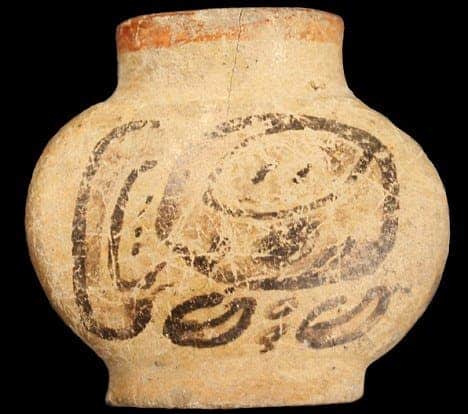
Archaeologists have uncovered an ancient urn dated from the Mayan classical period, which after a thorough chemical analysis was found to contain traces of nicotine. Though it has been documented in Mayan texts and folklore that tobacco use was a common part of the local community, this is the first hard evidence supporting the fact that Mayans smoked. Moreover, the same analysis has revealed that they tobacco consumed then was a lot stronger than today, almost hallucinogenic.
The 1,300-year-old Mayan flask actually literary had tobacco written all over it, marked with Mayan hieroglyphs reading “y-otoot ‘u-may,” which is translated as “the house of its/his/her tobacco.” A scientist at the Rensselaer Polytechnic Institute and an anthropologist from the University at Albany teamed up, after they saw this as an excellent opportunity, and used high-end chemical analysis to prove tobacco usage in Mayan culture.
Their discovery represents new evidence on the ancient use of tobacco in the Mayan culture and a new method to understand the ancient roots of tobacco use in the Americas.
The urn most probably contained tobacco leaves, however it is believed that the Maya also grounded tobacco into a powder which they used for all sorts of activities, from therapeutic (bug bite treatment) to protection against minions lurking in the jungle (burning tobacco powder is said to have been used as a snake repellent). Of course, the Mayan knew how to party hard. Powdered tobacco could be added to drinks for an extra kick or directly snorted.
‘This was very strong tobacco, much stronger than it is today,’ Jennifer Loughmiller-Newman, an archaeologist at the University of Albany in New York, told MSNBC.
‘Nicotiana rustica was nearly hallucinogenic.’
Dmitri Zagorevski, director of the Proteomics Core in the Center for Biotechnology and Interdisciplinary Studies(CBIS) at Rensselaer, the leading scientist involved in the study, used technology typically reserved for the study of modern diseases and proteins, to analyze the chemical fingerprints of the urn. This involved, among other, gas chromatography mass spectrometry (GCMS) and high-performance liquid chromatography mass spectrometry (LCMS).
‘Our study provides rare evidence of the intended use of an ancient container,’ said Zagorevski.
‘Mass spectrometry has proven to be an invaluable method of analysis of organic residues in archaeological artifacts.
‘This discovery is not only significant to understanding Mayan hieroglyphics, but an important archaeological application of chemical detection.’
via






